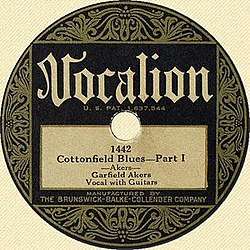Garfield Akers
Garfield Akers (possibly born James Garfield Echols, c. 1902 – c. 1959)[1] was an American blues singer and guitarist. He sometimes performed under the pseudonym "Garfield Partee."

Akers' extant recordings consist of four sides, which are nonetheless historically significant. His most well-known song was his debut, "Cottonfield Blues", a duet with friend and longtime collaborator Joe Callicott on second guitar,[2] based on a song performed by Texas blues musician Henry Thomas a few years earlier.
Biography
Akers lived in Hernando, Mississippi most of his life, working as a sharecropper and performing during off-hours at local house parties and dances. He was Walter Horton's stepfather.[1] He toured with Frank Stokes on the Doc Watts Medicine Show.[3] Akers was reportedly active on the south Memphis circuit throughout the 1930s. Akers and Callicott played together for more than twenty years, parting in the mid-1940s. Akers briefly resurfaced in the early 1950s. No photographs of Akers are known to exist.
Little is known of Akers' background or origins, and the name "Garfield Akers" is not found in official records.[1] Although birth years of 1897, 1901 and 1902 have been suggested,[4] researchers Bob Eagle and Eric LeBlanc suggest that he may have been born James Garfield Echols (a surname which may have been misheard as Akers) in about 1908, possibly at Aiken, Tate County, Mississippi. He reportedly died at Hernando, Mississippi, in about 1959.[1]
Historic impact of recordings
Jason Ankeny in AllMusic noted that Akers' recorded performances "reflect a distinctively insistent guitar style, and also reveal a high-pitched, almost otherworldly voice." Ankeny claims that Akers "was a primary influence on subsequent generations of Mississippi bluesmen, with the likes of John Lee Hooker and Robert Wilkins citing him as an influence."[5]
Blues historian Don Kent praised "Cottonfield Blues," saying "only a handful of guitar duets in all blues match the incredible drive, intricate rhythms and ferocious intensity." Kent also called Akers "one of the greatest vocalists in blues history." [6] Author/historian Michael Gray called this recording "the birth of rock 'n' roll … from 1929!" [7]
"Dough Roller Blues" was probably the first of many versions of "Roll and Tumble Blues" by Hambone Willie Newbern (Okeh Records 8679).[8]
Known discography
- "Cottonfield Blues, Part 1" / "Cottonfield Blues, Part 2," (1929), (Vocalion Records 1442)
- "Jumpin And Shoutin' Blues" / "Dough Roller Blues," (1930), (Vocalion Records 1481)
References
- Eagle, Bob; LeBlanc, Eric S. (2013). Blues - A Regional Experience. Santa Barbara: Praeger Publishers. pp. 219, 456. ISBN 978-0313344237.
- Robert Palmer. Deep Blues. Penguin Books. pp. 243–4. ISBN 978-0-14-006223-6.
- "Archived copy". Archived from the original on 2009-04-08. Retrieved 2009-06-29.CS1 maint: archived copy as title (link)
- "GARFIELD AKERS/JOE CALLICOT". Thebluestrail.com. Retrieved 5 February 2019.
- "Garfield Akers - Biography & History". AllMusic. Retrieved 5 February 2019.
- Don Kent, in: The Best There Ever Was, CD-Booklet, Yazoo Records, YA 3002, 2003
- Michael Gray: Song & Dance Man III – The Art of Bob Dylan, ISBN 0-8264-6382-7
- "John Tefteller's Museum Records Hambone Willie Newbern "Roll and Tumble Blues"". Archived from the original on March 15, 2012.
Bibliography
- Robert Santelli, The Big Book Of Blues – A Biographical Encyclopedia, 1993, ISBN 0-14-015939-8, p. 5